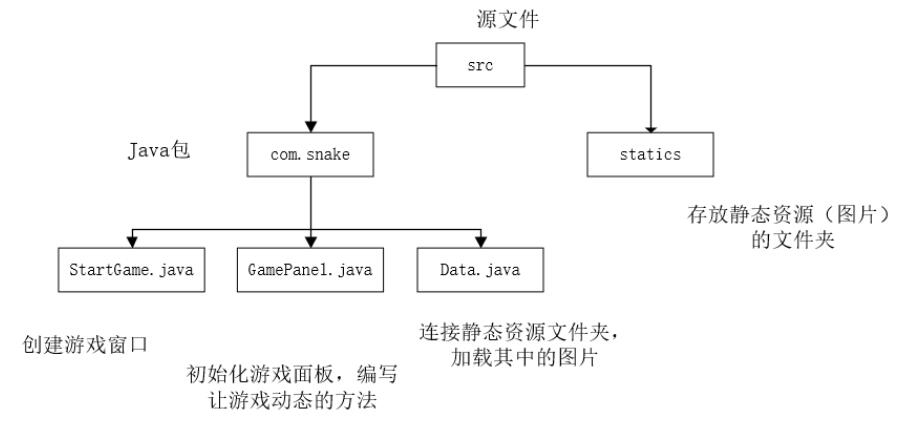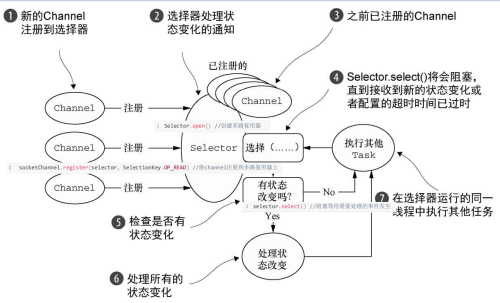浅谈Java中的三种IO模型及三种模型之间的区别
一、BIO(Blocking IO,也被称作old IO)
同步阻塞模型,一个客户端连接对应一个处理线程
对于每一个新的网络连接都会分配给一个线程,每隔线程都独立处理自己负责的输入和输出, 也被称为Connection Per Thread模式

缺点:
1、IO代码里read操作是阻塞操作,如果连接不做数据读写操作会导致线程阻塞,浪费资源
2、如果线程很多,会导致服务器线程太多,压力太大,比如C10K问题
所谓c10k问题,指的是服务器同时支持成千上万个客户端的问题,也就是concurrent 10 000 connection
应用场景: BIO 方式适用于连接数目比较小且固定的架构, 这种方式对服务器资源要求比较高, 但程序简单易理解。
示例代码如下:
Bio服务端
import java.io.IOException;
import java.net.ServerSocket;
import java.net.Socket;
/**
* @Title:BIO的服务端
* @Author:wangchenggong
* @Date 2021/4/13 9:41
* @Description
* @Version
*/
public class SocketServer {
public static void main(String[] args) throws IOException {
ServerSocket serverSocket = new ServerSocket(9000);
while (true){
System.out.println("等待连接...");
Socket clientSocket = serverSocket.accept();
System.out.println("客户端"+clientSocket.getRemoteSocketAddress()+"连接了!");
handle(clientSocket);
}
}
private static void handle(Socket clientSocket) throws IOException{
byte[] bytes = new byte[1024];
int read = clientSocket.getInputStream().read(bytes);
System.out.println("read 客户端"+clientSocket.getRemoteSocketAddress()+"数据完毕");
if(read != -1){
System.out.println("接收到客户端的数据:" + new String(bytes, 0, read));
}
clientSocket.getOutputStream().write("HelloClient".getBytes());
clientSocket.getOutputStream().flush();
}
}
Bio客户端
import java.io.IOException;
import java.net.Socket;
/**
* @Title:BIO的客户端
* @Author:wangchenggong
* @Date 2021/4/13 9:49
* @Description
* @Version
*/
public class SocketClient {
public static void main(String[] args) throws IOException {
Socket socket = new Socket("localhost", 9000);
//向服务端发送数据
socket.getOutputStream().write("HelloServer".getBytes());
socket.getOutputStream().flush();
System.out.println("向服务端发送数据结束");
byte[] bytes = new byte[1024];
//接收服务端回传的数据
socket.getInputStream().read(bytes);
System.out.println("接收到服务端的数据:" + new String(bytes));
socket.close();
}
}
二、NIO(Non Blocking IO,本意也作new IO)
同步非阻塞,服务器实现模式为 一个线程可以处理多个连接请求(连接),客户端发送的连接请求都会注册到多路复用器selector上,多路复用器轮询到连接有IO请求就进行处理,是在JDK1.4开始引入的。
应用场景:NIO方式适合连接数目多且连接比较短(轻操作)的架构,比如聊天服务器、弹幕系统、服务器之间通讯,编程相对复杂。

NIO 有三大核心组件: Channel(通道), Buffer(缓冲区),Selector(多路复用器)
1.channel类似于流,每个channel对应一个buffer缓冲区,buffer底层就是个数组
2.channel 会注册到selector上,由selector根据channel读写事件的发生将其交由某个空闲的线程处理
3.NIO的Buffer和Channel都是可读也可写的。
NIO的代码示例有两个
没有引入多路复用器的NIO
服务端
import java.io.IOException;
import java.net.InetSocketAddress;
import java.nio.ByteBuffer;
import java.nio.channels.ServerSocketChannel;
import java.nio.channels.SocketChannel;
import java.util.ArrayList;
import java.util.Iterator;
import java.util.List;
/**
* @Title:Nio服务端
* @Author:wangchenggong
* @Date 2021/4/14 11:04
* @Description
* @Version
*/
public class NioServer {
/**
* 保存客户端连接
*/
static List<SocketChannel> channelList = new ArrayList<>();
public static void main(String[] args) throws IOException {
//创建Nio ServerSocketChannel
ServerSocketChannel serverSocket = ServerSocketChannel.open();
serverSocket.socket().bind(new InetSocketAddress(9000));
//设置ServerSocketChannel为非阻塞
serverSocket.configureBlocking(false);
System.out.println("Nio服务启动成功");
while(true){
//非阻塞模式accept方法不会阻塞
/// NIO的非阻塞是由操作系统内部实现的,底层调用了linux内核的accept函数
SocketChannel socketChannel = serverSocket.accept();
if(socketChannel != null){
System.out.println("连接成功");
socketChannel.configureBlocking(false);
channelList.add(socketChannel);
}
Iterator<SocketChannel> iterator = channelList.iterator();
while(iterator.hasNext()){
SocketChannel sc = iterator.next();
ByteBuffer byteBuffer = ByteBuffer.allocate(128);
//非阻塞模式read方法不会阻塞
int len = sc.read(byteBuffer);
if(len > 0){
System.out.println("接收到消息:" + new String(byteBuffer.array()));
}else if(len == -1){
iterator.remove();
System.out.println("客户端断开连接");
}
}
}
}
}
客户端
import java.io.IOException;
import java.net.InetSocketAddress;
import java.nio.ByteBuffer;
import java.nio.channels.SocketChannel;
/**
* @Title:Nio客户端
* @Author:wangchenggong
* @Date 2021/4/14 11:36
* @Description
* @Version
*/
public class NioClient {
public static void main(String[] args) throws IOException {
SocketChannel socketChannel=SocketChannel.open(new InetSocketAddress("localhost", 9000));
socketChannel.configureBlocking(false);
ByteBuffer writeBuffer=ByteBuffer.wrap("HelloServer1".getBytes());
socketChannel.write(writeBuffer);
System.out.println("向服务端发送数据1结束");
writeBuffer = ByteBuffer.wrap("HelloServer2".getBytes());
socketChannel.write(writeBuffer);
System.out.println("向服务端发送数据2结束");
writeBuffer = ByteBuffer.wrap("HelloServer3".getBytes());
socketChannel.write(writeBuffer);
System.out.println("向服务端发送数据3结束");
}
}
引入了多路复用器的NIO
服务端
import java.io.IOException;
import java.net.InetSocketAddress;
import java.nio.ByteBuffer;
import java.nio.channels.*;
import java.util.Iterator;
import java.util.Set;
/**
* @Title:引入多路复用器后的NIO服务端
* @Author:wangchenggong
* @Date 2021/4/14 13:57
* @Description
* SelectionKey.OP_ACCEPT —— 接收连接继续事件,表示服务器监听到了客户连接,服务器可以接收这个连接了
* SelectionKey.OP_CONNECT —— 连接就绪事件,表示客户与服务器的连接已经建立成功
* SelectionKey.OP_READ —— 读就绪事件,表示通道中已经有了可读的数据,可以执行读操作了(通道目前有数据,可以进行读操作了)
* SelectionKey.OP_WRITE —— 写就绪事件,表示已经可以向通道写数据了(通道目前可以用于写操作)
*
* 1.当向通道中注册SelectionKey.OP_READ事件后,如果客户端有向缓存中write数据,下次轮询时,则会 isReadable()=true;
*
* 2.当向通道中注册SelectionKey.OP_WRITE事件后,这时你会发现当前轮询线程中isWritable()一直为true,如果不设置为其他事件
* @Version
*/
public class NioSelectorServer {
public static void main(String[] args) throws IOException {
/**
* 创建server端,并且向多路复用器注册,让多路复用器监听连接事件
*/
//创建ServerSocketChannel
ServerSocketChannel serverSocket = ServerSocketChannel.open();
serverSocket.socket().bind(new InetSocketAddress(9000));
//设置ServerSocketChannel为非阻塞
serverSocket.configureBlocking(false);
//打开selector处理channel,即创建epoll
Selector selector = Selector.open();
//把ServerSocketChannel注册到selector上,并且selector对客户端的accept连接操作感兴趣
serverSocket.register(selector, SelectionKey.OP_ACCEPT);
System.out.println("NioSelectorServer服务启动成功");
while(true){
//阻塞等待需要处理的事件发生
selector.select();
//获取selector中注册的全部事件的SelectionKey实例
Set<SelectionKey> selectionKeys = selector.selectedKeys();
Iterator<SelectionKey> iterator = selectionKeys.iterator();
//遍历selectionKeys,对事件进行处理
while (iterator.hasNext()){
SelectionKey key = iterator.next();
//如果是OP_ACCEPT事件,则进行连接和事件注册
if(key.isAcceptable()){
ServerSocketChannel serverSocketChannel = (ServerSocketChannel) key.channel();
//接受客户端的连接
SocketChannel socketChannel = serverSocketChannel.accept();
socketChannel.configureBlocking(false);
//把SocketChannel注册到selector上,并且selector对客户端的read操作(即读取来自客户端的消息)感兴趣
socketChannel.register(selector, SelectionKey.OP_READ);
System.out.println("客户端"+socketChannel.getRemoteAddress()+"连接成功!");
}else if(key.isReadable()){
SocketChannel socketChannel = (SocketChannel) key.channel();
ByteBuffer byteBuffer = ByteBuffer.allocate(128);
int len = socketChannel.read(byteBuffer);
if(len > 0){
System.out.println("接收到客户端"+socketChannel.getRemoteAddress()+"发来的消息,消息内容为:"+new String(byteBuffer.array()));
}else if(len == -1){
System.out.println("客户端断开连接");
//关闭该客户端
socketChannel.close();
}
}
//从事件集合里删除本次处理的key,防止下次select重复处理
iterator.remove();
}
}
/**
* NioSelectorServer服务启动成功
* 客户端/127.0.0.1:57070连接成功!
* 接收到客户端/127.0.0.1:57070发来的消息,消息内容为:HelloServer
* 客户端/127.0.0.1:57121连接成功!
* 接收到客户端/127.0.0.1:57121发来的消息,消息内容为:HelloServer
*/
}
}
客户端
import java.io.IOException;
import java.net.InetSocketAddress;
import java.nio.ByteBuffer;
import java.nio.channels.SelectionKey;
import java.nio.channels.Selector;
import java.nio.channels.SocketChannel;
import java.util.Iterator;
import java.util.Set;
/**
* @Title:引入多路复用器后的NIO客户端
* @Author:wangchenggong
* @Date 2021/4/14 14:39
* @Description
* @Version
*/
public class NioSelectorClient {
public static void main(String[] args) throws IOException {
SocketChannel socketChannel = SocketChannel.open();
socketChannel.configureBlocking(false);
Selector selector = Selector.open();
//要先向多路复用器注册,然后才可以跟服务端进行连接
socketChannel.register(selector, SelectionKey.OP_CONNECT);
socketChannel.connect(new InetSocketAddress("localhost", 9000));
while (true){
selector.select();
Set<SelectionKey> keys = selector.selectedKeys();
Iterator<SelectionKey> iterator = keys.iterator();
while (iterator.hasNext()){
SelectionKey key = iterator.next();
iterator.remove();
if (key.isConnectable()){
SocketChannel sc = (SocketChannel) key.channel();
if (sc.finishConnect()){
System.out.println("服务器连接成功");
ByteBuffer writeBuffer=ByteBuffer.wrap("HelloServer".getBytes());
sc.write(writeBuffer);
System.out.println("向服务端发送数据结束");
}
}
}
}
/**
* 服务器连接成功
* 向服务端发送数据结束
*/
}
}
三、AIO(Asynchronous IO) 即NIO2.0
异步非阻塞,由操作系统完成后回调通知服务端程序启动线程去处理,一般适用于连接数较多且连接时间较长的应用。
应用场景:AIO方式适用于连接数目多且连接时间较长(重操作)的架构(应用),JDK7开始支持。
著名的异步网络通讯框架netty之所以废弃了AIO,原因是:在Linux系统上,NIO的底层实现使用了Epoll,而AIO的底层实现仍使用Epoll,没有很好实现AIO,因此在性能上没有明显的优势,而且被JDK封装了一层不容易深度优 化,Linux上AIO还不够成熟
AIO示例代码如下:
服务端
import java.net.InetSocketAddress;
import java.nio.ByteBuffer;
import java.nio.channels.AsynchronousServerSocketChannel;
import java.nio.channels.AsynchronousSocketChannel;
import java.nio.channels.CompletionHandler;
/**
* @Title:Aio服务端
* @Author:wangchenggong
* @Date 2021/4/14 17:05
* @Description
* @Version
*/
public class AioServer {
public static void main(String[] args) throws Exception {
final AsynchronousServerSocketChannel serverChannel = AsynchronousServerSocketChannel.open().bind(new InetSocketAddress(9000));
serverChannel.accept(null, new CompletionHandler<AsynchronousSocketChannel, Object>() {
@Override
public void completed(AsynchronousSocketChannel socketChannel, Object attachment) {
try{
System.out.println("2--"+Thread.currentThread().getName());
//接收客户端连接
serverChannel.accept(attachment,this);
System.out.println("客户端"+socketChannel.getRemoteAddress()+"已连接");
ByteBuffer buffer = ByteBuffer.allocate(128);
socketChannel.read(buffer, null, new CompletionHandler<Integer, Object>() {
@Override
public void completed(Integer result, Object attachment) {
System.out.println("3--"+Thread.currentThread().getName());
//flip方法将Buffer从写模式切换到读模式
//如果没有,就是从文件最后开始读取的,当然读出来的都是byte=0时候的字符。通过buffer.flip();这个语句,就能把buffer的当前位置更改为buffer缓冲区的第一个位置
buffer.flip();
System.out.println(new String(buffer.array(), 0, result));
socketChannel.write(ByteBuffer.wrap("hello Aio Client!".getBytes()));
}
@Override
public void failed(Throwable exc, Object attachment) {
exc.printStackTrace();
}
});
}catch(Exception e){
e.printStackTrace();
}
}
@Override
public void failed(Throwable exc, Object attachment) {
}
});
System.out.println("1‐‐main"+Thread.currentThread().getName());
Thread.sleep(Integer.MAX_VALUE);
}
/**
* 1‐‐mainmain
* 2--Thread-9
* 客户端/127.0.0.1:54821已连接
* 3--Thread-8
* hello AIO server !
* 2--Thread-9
* 客户端/127.0.0.1:54942已连接
* 3--Thread-7
* hello AIO server !
*/
}
客户端
import java.net.InetSocketAddress;
import java.nio.ByteBuffer;
import java.nio.channels.AsynchronousSocketChannel;
/**
* @Title:Aio客户端
* @Author:wangchenggong
* @Date 2021/4/14 16:56
* @Description
* @Version
*/
public class AioClient {
public static void main(String[] args) throws Exception {
//创建Aio客户端
AsynchronousSocketChannel socketChannel = AsynchronousSocketChannel.open();
socketChannel.connect(new InetSocketAddress("localhost", 9000)).get();
//发送消息
socketChannel.write(ByteBuffer.wrap("hello AIO server !".getBytes()));
//接收消息
ByteBuffer buffer = ByteBuffer.allocate(128);
Integer len = socketChannel.read(buffer).get();
if(len != -1){
//客户端收到消息:hello Aio Client!
System.out.println("客户端收到消息:"+new String(buffer.array(), 0, len));
}
}
}
四、总结
| BIO | NIO | AIO | |
| IO模型 | 同步阻塞 | 同步非阻塞 | 异步非阻塞 |
| 编程难度 | 简单 | 复杂 | 复杂 |
| 可靠性 好 | 差 | 好 | 好 |
| 吞吐量 | 低 | 高 | 高 |
到此这篇关于 Java 中三种 IO 模型的简单介绍以及总结三者之间区别的文章就介绍到这了,想要了解更多相关 Java IO 模型的其他详细内容请搜索W3Cschool以前的文章或继续浏览下面的相关文章,也希望大家以后多多支持!